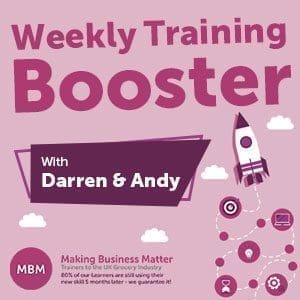Podcast: Play in new window | Download
Episode 4 – Have you ever attended a 1-day training course, returned to the office and done nothing different.
You’re one of many who fail to make learning stick.
The return on time & money invested is therefore zero.
In this podcast, we discuss this common story; you work in the corporate world, you attend 1-day training courses. You come back and get on with your work. Nothing changes. We spend 10 years at school going to lesson after lesson. Yet, we then get out into the big wide world and expect to learn a skill between 9-5 in a training course. It simply can not happen.
Similar to when you learnt to drive. The average person takes 40 driving lessons. And then they pass. In the science of learning, this is called, ‘Spaced Repetition’. It simply means that we learn, we take a break, we learn, we take a break, and so on. Also, we are applying what we are learning all the time, as we drive. In short, we are making the learning stick. Yet on 1-day training courses, we learn the theory, there is some practice, but not enough.
Read the Make Learning Stick Podcast Transcript:
“People go on one-day training courses, come back, and nothing’s changed. My name is Darren Smith, and you’re at home with Sticky Learning MBM, trainers to the UK grocery industry. So I spent 15 years in the corporate world and I attended one-day training courses. HR would come along or you’d have your appraisal and there’ll be a list of courses that you could attend, my team could attend, and you’d worked through some sort of very complex process to arrive at Bob needed time management skills, or John needed negotiation skills, and the date was set with HR. These guys went on a training course normally with a bunch of other companies, but it could be internal.”
No One Questions Why Our Behaviours Don’t Change Following Training
“Now here’s the surprising thing. We go to school, we have double English every week, if not two lots, for many, many years to try and get us to understand that topic and then when we leave school, we go to the corporate world, spend a huge amount on training. I’d expect our behaviours to change and of course, they don’t and no one really questions it. You’d go on a course, you come back, your manager might say, “How was it?” That was fine. And you try and get on with the rest of your day, which was piling up. And that’s all you really thought about whilst you were on this one-day training course.”
“So for 50 plus years, who can blame anyone? The norm is you go on a one-day training course, you come back and nothing changes. Nowadays, the learning gurus understand about blended learning or 70/20/10, but what I want to talk about is really simple. It’s doing learning or training and then changing behaviour. Because if you’re not, all that’s happening is learning transfer. You’re going on a course or you’re talking to someone or you’re learning something and they’re passing on that information, but you’re not doing anything with it. As someone once said, information without application is just entertainment. And whilst the courses that I’m sure you’re going on aren’t that entertaining, that’s all that’s happening. You’re being entertained. Because we’re not achieving that crucial behavioural change. Aye, you’re doing something different when you’re at work.”
Three Simple Steps to Get the Most from Your Training Investment and Make Learning Truly Stick
“So I want to talk through three simple things that can be done in order to get the very most out of your investment in training, be you were learner or an HR manager and we talk to a lot of HR managers that are fried, frustrated because their people come back from training courses and nothing has changed. Yet they’ve ticked a box, and if ticked boxing is all you want to do, then this isn’t for you. If you genuinely want the learner to get a better return on investment from their time, and you for your company getting a better return on your money spent, then doing something different is crucial. Let me take you through these three steps.”
My New iPhone
“A few weeks ago I got a brand new iPhone, a seven. I’m not quite up to date with the kids, but a seven isn’t bad. When I opened that box, I’m excited and I’m turning it on, pairing up and I’m trying all these different things. I’m using the different apps, the bits of technology, the heart function on it. I’m interested. So I’m interested, so my individual learning objective, whilst not quite conscious, was I want to learn it because I’m excited, because I’m interested, because I think it will add some value to my life and also it’s a little something to talk about. So my individual learning objective, my ILO is I want to understand it for me. Everyone needs an individual learning objective. Now once we get to that point of people understanding I’m going on a course or I’m doing a piece of learning or it’s a seven-day course, it doesn’t really matter, as long as it’s a piece of learning. Once they understand that they need to know what’s in it for them, what are they want to get from it?”
Simple Individual Learning Objectives to Make Learning Stick
“And what I don’t mean is I want to be a better time manager. That simply won’t work because they’re ticking a box. It has to be truly about them. I want to go home at five every night. I want to be less stressed. Also, I want to manage this project so much better and deliver it on time. That’s what we want. Now they’ll learn a whole bunch of other things. What we need to make sure is that they have what they truly want and it has to be a problem. The problem is this. And it has to be specific, ideally a smart individual learning objective, but let’s just start with something specific to them that’s a problem. I don’t get this iPhone phone thing and how it works, therefore I’m going to go and fix that. I keep getting beaten up by my bar in negotiation skills and I don’t want to be beaten up anymore. Let’s fix that. So, part one is the learner needs an individual learning objective or put really simply, what the hell do they want to get out of the time that they’re investing in this learning?”
Learning to Drive
“Part two. I was 17. I’m at home. Mom and dad were excited. We’re in the living room. It’s my birthday. Now, as a surprise present, they said, “Look out the window.” And there it is. The car with the L on top. My heart sank. And I didn’t know then what I know now, the reason my heart sank. So mom and dad have bought me a present. Of course, I went outside. Talked to Dave, my new driving instructor. He said, get in the car in the driver’s side. He pretty much went through, there’s the steering wheel, these are the pedals, that’s go, let’s… Off we go.”
“I came back after an hour. Mum, Dad said, “How was it?” I just said I’d hated it. Now, I didn’t want to say that, it was my birthday present, but I did. I absolutely hated it. And what I understand now, but didn’t back then, is that my driving instructor was an activist. Now there’s a lot of research around whether learning styles exist or not. Let’s not get sucked into that. Let’s say there is something about how we prefer to learn with a particular activity and it can change. So my driving instructor was an activist, which was pretty much, there it is getting on with it. My learning style’s reflector, which means I want to have a think about it. I want stuff to be explained and then me to go slightly daydreaming and then I’ll come back. There is some science around the mnemonic, P-A-R-T, which is pragmatist activist, reflect to theorist, which suggests you go through all four of those learning styles, but you just join that roundabout at a different place.”
People Learn in Different Ways
“For now, let’s just say that people learn very differently and they need to consume the learning in the way they want to consume. So for you at your desk, if you’re teaching someone Excel, you might not get the best out of them if you show them how to do it. They might need to do it, which is an activist or you might need to explain it and then they’ll come back later and say, did you mean this? That’s a reflector. So allow the learners to consume the learning in the way they need to learn it best. And they may not even know it, but introduced an activist and reflector at least we start that common language.”
Ebbinghaus
“The last one comes back to some old research, we’re talking mid-1800s, by a German psychologist called Herman Ebbinghaus. Now broadly, what he said was that if you don’t use what you’ve learned after 30 days, you’ll lose it. Now, there’s a lot more to the science that you came up with, but we’re talking very old science that’s still very useful today. So, if you’ve go on a one-day training course and you don’t use what you’ve learned within 30 days, it will be gone. What a waste. What a shame. You will have failed to make your leaning stick. So, we need to use what we’ve learnt.”
Creating Habits for Long Term Change
“B.J. Fogg is a professor at Stanford. He’s the grandfather of habit formation. I’m introducing him because I want you to understand that you need to create a habit. So for me, I broke my foot some years ago playing volleyball, a fantastic leap in the air, at least eight feet off the ground, or at least I thought it was, came down, broke my foot. The doctor gave me exercises to get my ankle strength back. The best way to do that was for me to tack the habits, the behaviour onto an existing habit. So imagine me brushing my teeth every morning, toothbrush in my right hand, toothbrush in my mouth, left foot, swinging around for the two or three minutes it took me to brush my teeth.”
“If you want to change your behaviour because you’ve learnt something new, piggyback it onto a current habit. Like me brushing my teeth, I did my ankle exercises. For you, it might be time management. You need to write your daily to-do list. So before you open the lid of your laptop, and maybe your to-do list is in the lid of your laptop, and that’ll remind you to write your to-do list before you get stuck into your emails. Try and disrupt your behaviour. Try and add it on to a current habit.”

Final Thoughts
“So in summary, one-day training courses don’t work. They fail to make the learning stick. The science proves that. If you want to get more out of your learning, one, figure out what’s in it for you. Two, begin to understand how you want to consume the material. And three, do something with it within 30 days, ideally adding it onto a current habit that you do. Thank you.”




